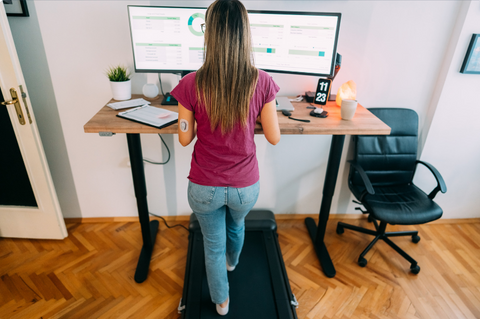0344 755 3018
0344 755 3018

As the British workforce continues to evolve, so too does the environment in which it operates. A modern twist on traditional office furniture that has gained popularity in recent years is the height-adjustable or standing desk. Before you dive headfirst into this new trend, let's delve into the world of standing desks - their origins, benefits, health implications, and whether they justify their higher price point.
Standing desks have become popular only in the past few years, but their origins trace back much further. Many historical figures, including Leonardo da Vinci, Winston Churchill, and Ernest Hemingway, were known to favour working on their feet. These innovators and leaders might have been on to something before their time!
However, the concept of a height-adjustable or standing desk has only gained mainstream traction within the last decade. This surge can be attributed to the increasing awareness of health issues linked to sedentary behaviour and the rising popularity of flexible workspace design.
There's a familiar saying that "sitting is the new smoking," but is standing really that much better? The answer isn't as straightforward as you might think.
Prolonged sitting can lead to numerous health problems such as obesity, heart disease, and even certain types of cancer. On the other hand, standing all day isn't necessarily the panacea it's made out to be. It can lead to its own set of issues, such as back, foot, and leg pain.
The key here is balance. Alternating between sitting and standing throughout the day allows you to reap the benefits of both postures without the drawbacks. This is where height-adjustable desks come into their own, allowing you the flexibility to switch between sitting and standing at your convenience.

The health benefits of standing desks are primarily tied to increased physical activity. By standing, you burn more calories than sitting, which can contribute to weight loss and overall cardiovascular health. Regularly alternating between sitting and standing can also help alleviate common workplace issues such as back pain and repetitive strain injuries.
Additionally, a 2018 study published in the British Medical Journal found that standing desks can boost productivity by as much as 46% and this Harvard report explores the health benefits. Employees who used standing desks reported less fatigue, increased engagement, and improved concentration and task completion.
However, it's important to note that standing desks are not a silver bullet for office-related health issues. They should be combined with other healthy behaviours like regular exercise, a balanced diet, and good ergonomic practices.
Price is often a sticking point when considering standing desks. They tend to be more expensive than their fixed-height counterparts, with prices varying depending on the model, features, and manufacturer.
However, it's crucial to look beyond the initial cost and consider the potential long-term benefits. By reducing health problems and boosting productivity, standing desks can pay for themselves over time. Moreover, many employers recognise these benefits and may be willing to subsidise the cost of standing desks for their employees.
If you're self-employed or your employer doesn't offer such a scheme, you can start small with a low-cost, desktop riser model before investing in a full-size, height-adjustable desk.
There's no one-size-fits-all answer to this question. It depends on various factors, including your physical condition, the nature of your work, and your budget.
If you suffer from back pain, are concerned about the health effects of prolonged sitting, or simply want more flexibility in your workspace, a standing desk may be worth considering.
However, remember that a standing desk is a tool, not a cure-all. It should be part of an overall approach to health and well-being at work that includes regular exercise, a healthy diet, and good ergonomics.
In conclusion, standing desks represent a significant shift in office ergonomics and culture. While they do come with a higher price tag, their health and productivity benefits could potentially justify the cost.
Before making a decision, it's essential to evaluate your individual needs and circumstances. You might find that the standing desk is not just a modern-day fad, but a worthwhile investment in your health, productivity, and overall work experience.